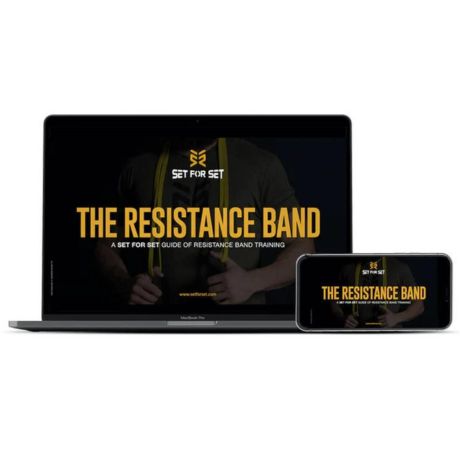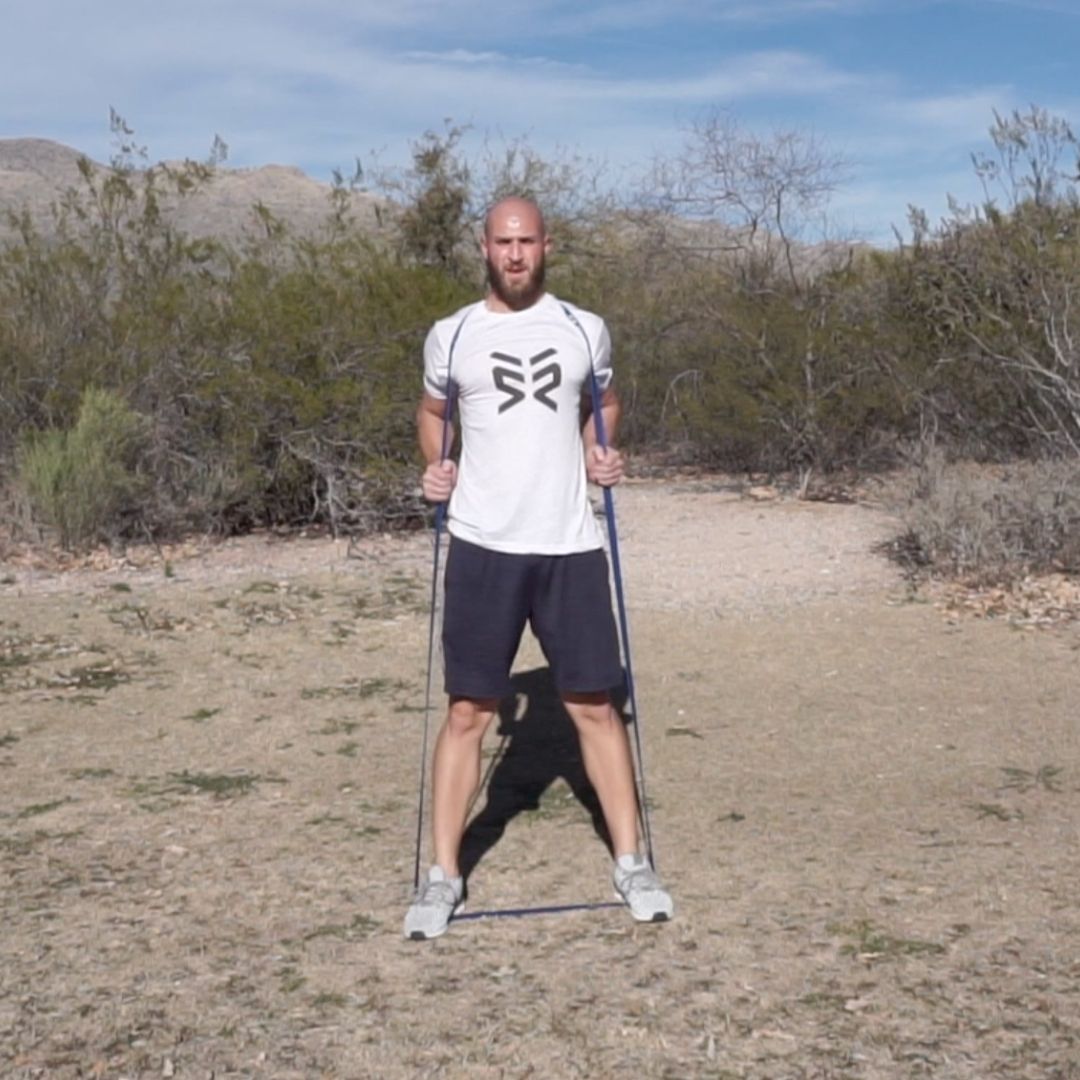With the right intensity, a resistance band leg workout can build strength and muscle mass in your quads, hamstrings, glutes and calves. All you have to do is use a resistance band size that will challenge you effectively for each exercise, fully engage your muscles with good form, slow down your reps if need be, and focus on mind muscle connection.
In this article, we will cover the following:
Take Your Fitness To The Next Level
- What you need to know about resistance bands for leg workouts
- What resistance bands are best for leg exercises
- The best resistance band leg exercises for real results
- Resistance band leg workouts to follow
- FAQ about training leg muscles with resistance bands

Are resistance bands good for leg workouts?
Yes, resistance bands are great building and strengthening leg muscles. There really isn't much of a learning curve with banded leg exercises either, considering the movements are pretty much identical to free weight exercises. Positioning and anchoring the band might be unique, but the biomechanics are the same.
If you are creative enough, you can replicate nearly every single free weight exercise with a band, and you are going to see twelve examples of this with the featured resistance band leg exercises below.
Related: Resistance Bands vs Free Weights
What lower body muscles can resistance bands target?
Resistance bands can target all of your major muscle groups, such as your quads, hamstrings, glutes, and calves.
You can perform exercises like squats, lunges, glute kickbacks, horizontal side steps, calf raises, leg curls, and more.
We have put together the 13 best resistance band leg exercises for building muscle and strength. We will run you through them below before providing you workouts that incorporate each.

Our guide has over 250 exercises categorized by mobility, mobilization, resistance training, barbell training, explosive training, static stretching, and (p)rehabilitation...
How do leg exercises with resistance bands work?
Unlike free weight training, which work your legs using gravity, resistance bands work your muscles through elastic tension and depending on the movement, you'll also be moving your body weight through gravity, so you'll get both types of force.
Overall, the external force of gravity and elastic tension works similarly to strength and build your muscle.
The main disadvantages of bands are your loading capabilities are capped at a much lower amount, and it's harder to progressive overload.
However, the advantages of bands are it is safer and easier on your joints (particularly your spine), and you'll have a lot more versatility and efficiency in your training. Bands also do a better job of targeting small joint complex stabilizer muscles, simply due to how the elastic tension puts stability during movement at the forefront.
Nevertheless, you can, of course, do both resistance band leg exercises and free weight leg exercises. The different training stimulus will actually benefit your fitness.
Not to mention, you can even combine free weights (like barbells) with bands during strength training.
All that said, you will need to consider (as you do with free weights too) the right size resistance band to use to challenge yourself accordingly while maintaining proper form.
What kind of resistance bands for leg exercises?
The best resistance bands for leg exercises that will actually put on mass and help you develop strength are heavy duty 41" loop resistance bands, as seen in this post.

This type of resistance band has the highest range of resistance (depending on the size of the band, from 5-200lbs). Moreover, they are the most versatile type of resistance band. You can easily add resistance to any movement, as well as replicate free weight exercises and cable machine exercises. For legs, resistance bands are fantastic.
13 Best Resistance Band Leg Exercises for Your Workouts
Here are the 13 exercises that we will be using to formulate resistance band leg workouts. The exercises are all based on fundamental movement patterns: Squat, Hip Hinge, Lunge. These will offer you the biggest bang for your buck when training for strength, hypertrophy, and weight loss.
1. Resistance Band Back Squat

The back squat is a staple for leg days at the gym. As it should be for resistance band leg days too. To do this, you simply stand on the band with your feet shoulder width apart. Grab the band with your hands then come to a standing position and press it up and over your head to lay it along your traps. Make sure the band isn't causing pressure on your neck. If it is, bringing further down the back (about mid trap). Squat as you normally would, but to get the most out of this resistance band exercise, perform a slow eccentric (slowly bring your hips down).
2. Resistance Band Sumo Squat

The sumo squat is not as popular as the sumo deadlift (which is further below). You'll likely only see serious strength athletes doing it. Likely, this is because squatting with a wide stance can be hard on your hips. However, with resistance bands, you eliminate most of this issue. There won't be a heavy load on your spine and hips, and the movement feels very good with bands. It works all the same muscles as the back squat, but you'll feel a particularly stronger contraction in your glutes (hip abductor muscles) and your hip flexors.
3. Resistance Band Front Squat

Can't talk squats without the front squat. While not the most common squat by any means, pros use it for a reason, it hits the quads really well. You'll stand with a bit narrower of a stance (feet hip width apart), allowing more range of motion in the knee, and thus more quadricep activation. A big difference with a band and a barbell is that a band is easier to use. Since the placement is the same, it can even help you perfect the form, while still adequately targeting the quads in training. PS. If you have low back pain when doing back squats, you may find the front squat to be a lot more comfortable.
4. Resistance Band Zercher Squat

We think you will like this one. The Zercher squat will allow you to use a very heavy band (relative to your strength). Now, what makes this a Zercher squat is simply the way you'll be holding the band. It is taken from the barbell Zercher hold, which looks exactly the same. The barbell runs along the creases of your elbow and you hold the weight in position with your arms flexed. Like the front squat, it's a great way to load the quads.
5. Resistance Band Overhead Squat

The overhead squat takes requires good mobility. If not, you'll like feel uncomfortable in your spine, likely mid back, and it'll be hard to keep your hands overhead. When it comes to barbells, the overhead squat is usually saved for Crossfit and athletes. It's a very tough exercise, and might not be the safest. Yet, with bands, you don't need to worry. Start with a light band if your mobility is lacking, and practice. It'll get better! The overhead squat is a great way to maintain mobility and it's just an overall good, total body exercise (that's right, upper body and lower body at the same time!).
6. Resistance Band Cossack Squat

The last of our squats is the cossack squat. Another great mobility hack. The cossack is great for improving mobility as you'll move your hips and knees through a very wide range of motion. In turn, you'll also be strengthening those muscles. If this exercise is new to you, be sure to take time to practice it without a band. PS. If you are moving towards your right foot (which will be the working side), then your right foot can be planted to the ground, or on your heel as seen in the pic above (it'll depend on what feels most comfortable to you).
7. Resistance Band Lunge

The lunge is another staple for your workouts. It's a unilateral leg exercise so it will iron out muscle imbalances, while placing emphasis on the quadriceps and glutes, and improving your balance and coordination. Quick tip, be sure to wrap the resistance band tightly around your hands so you have tension at the bottom portion of the movement. You don't want any slack in the band as you lower down with your front foot.
8. Resistance Band Bulgarian Split Squat

Squat? Lunge? Doesn't matter. The Bulgarian Split Squat is a fantastic exercise for the legs. And due to the nature of it, it is just as good with bands in terms of weight load as it is with dumbbells. But bands will actually challenge you a little more, so you need to take that into account. The only issue is, dumbbells are easier to set up and begin. Either way, this is a great exercise for moving through a wide range of motion, which means you are going to be recruiting a lot of muscle fibers in your quads, hamstrings, glutes, and even your calves.
9. Resistance Band Deadlift

The resistance band deadlift can be an explosive movement or a more slow and controlled motion. It's very similar to the barbell deadlift, the only difference is your hands have the freedom of moving into a neutral position, which would be more like a trap bar deadlift. In any case, it's effective for building strength through the posterior chain and quads. Just be sure to try to keep your feet flat to the ground, as pulling up on the band can throw off your stability a bit.
10. Resistance Band Single Leg Deadlift

The single leg deadlift is harder with a band than a dumbbell. The set up can be a bit awkward, but it is effective. It requires a lot more stability, which is saying a lot as the one leg deadlift with dumbbells also demands balance through strong calves, thighs, and glutes. If you manage the set up properly, you'll get a nice contraction through your hamstrings, as you feel the burn of all the stabilizer muscles working through isometric contraction.
11. Resistance Band Sumo Deadlift

Unlike the sumo squat, the sumo deadlift gets a lot of love in gyms. It's a great way to build up the hip abductors, hip flexors and glutes as you can use a heavy load without putting pressure on your hips from downward force. While barbells are great, bands work really well too, especially with the set up you see in the pic above. You will certainly feel a great contraction in your glutes and thighs with this one.
12. Resistance Band Romanian Deadlift

The resistance band RDL is surprisingly really effective. It hits the hamstrings and glutes very well. The set up is the same as the resistance band deadlift, but you'll want to keep your hands in an overhand position above the center of your thighs. To get into the starting position, perform a traditional deadlift. From there, perform your first RDL rep. Be sure to keep your knees bent slightly and move slowly on the eccentric. If you keep your legs straight, it's a very similar movement called the stiff-legged deadlift.
13. Resistance Band Glute Bridges

Last but certainly not least, the glute bridge. This is the best band version of the barbell hip thrust. It's a hip hinge movement, like the deadlift, but through the horizontal plane. The movement is powered by the hamstrings and glutes, as well as a strong core. The glute bridge or hip thrust really completes this list of resistance band leg exercises as we've covered all of the most important compound movement patterns.
More Resistance Band Leg Exercises:
3 Resistance Band Leg Workouts
Here are several effective resistance band leg workouts using different protocols and with different goals in mind. Each will pull from the exercises above.
1. Sets x Reps for Hypertrophy & Strength:
- Resistance Band Back Squats: 4 sets x 10-15 reps
- Resistance Band Deadlifts: 4 sets x 8-12 reps
- Resistance Band Glute Bridges: 3 sets x 10 reps (pause at top each rep)
- Resistance Band Bulgarian Split Squat or Lunges: 3 sets x 10-15 reps (left leg and right leg)
- Resistance Band RDLs: 3 sets x 10-15 reps
2. Intense Resistance Band Circuit Leg Workout for Weight Loss and Overall Fitness:
Perform each exercise for the given reps back to back until you complete all 6 exercises. Then, rest for 1-2 minutes and repeat. Do 2-4 rounds in total.
- Resistance Band Overhead Squats
- Resistance Band Front Squats x 10 reps
- Resistance Band Zercher Squats x 10 reps
- Resistance Band Deadlifts x 10 reps
- Resistance Band RDLs x 10 reps
- Resistance Band Sumo Deadlift x 10 reps
3. Resistance Band Lower Body AMRAP Workout for Metabolic Conditioning:
Perform as many ROUNDS as possible in a 5, 10, or 15 minute time period. Choose the level appropriate for you.
- Resistance Band Back Squats x 10 reps
- Resistance Band Sumo Squats x 10 reps
- Resistance Band Deadlift x 10 reps
- Resistance Band Sumo Deadlift x 10 reps

The SFS FIVE Resistance Band Workout Package has 5 fun and challenging full length workouts using only resistance bands. Each workout targets different muscle groups. Together, the 5 workouts make for the perfect weekly workout routine.
FAQ:
Let's go over some common questions about resistance bands and leg training.
How many reps should I do for resistance band leg exercises?
For lower body exercises, you will want a band that challenges you for sets of 12-15 reps (with good form).
If you can easily complete 12-15 reps, move up in band size...
Now, for the exercises featured in this post, we’ve noticed the best results with slightly higher reps. Higher volume in general is more effective with bands OR just slower tempo. A slow eccentric phase (downward motion) is ideal.
Can resistance bands build the glutes?
You can grow your glutes (aka your booty) with bodyweight only exercises if you do the right amount of volume and intensity, so you can definitely grow your glutes with bands.
In fact, bands are one of the best training tools for targeting the booty. This is one of the reasons for their rise in popularity. Even people who go to the gym to use free weights will bring resistance bands so they can do resistance band exercises for their glutes too.
There are many resistance band glute exercises, and you can hit your glutes from all angles. Essentially you can replicate free weight exercises and cable machine exercises with the 41" resistance bands you see in this post.
Check out these banded glute exercises by our friend Michael Drach Training.
Are resistance bands good for lower body mobility exercises?
Resistance bands are a great tool for joint mobilization exercises and stretching. They allow you to create deeper leg stretches and release pressure around joints like your hips and ankles. Bands also work well for strengthening and mobilizing the knee joint, such as with these knee pain exercises.
If you aren't familiar, joint mobilization is a form of passive movement that is beneficial for improving range of motion, mitigating capsular restrictions and breaking adhesions, among other benefits. Joint mobilization is a great form of manual therapy. It provides therapeutic effects for those who train frequently, such as bodybuilders, powerlifters, and athletes.
Other resistance band targeted workouts:
- Resistance Band Shoulder Workout
- Resistance Band Chest Workout
- Resistance Band Back Workout
- Resistance Band Bicep Exercises
- Resistance Band Tricep Exercises
- Resistance Band Core Exercises






0 comments